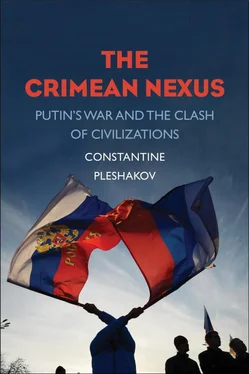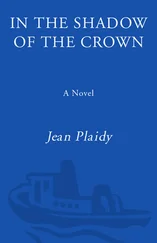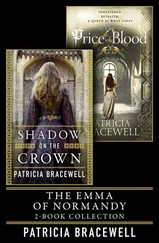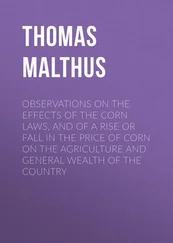Crimean Russophiles hoped reunification would bring structure and order. A Russian anthropologist has called Crimea an “oasis of conservatism,” a condition originating in the service industry built around government residences, in the power of the military, and in the prejudices and insecurities of Russian and Ukrainian settlers now occupying Tatars’ land. Vladimir Putin’s system of governance was built on conservative values. The appeal of order, even if not necessarily coupled with law, increased dramatically after the extremist wing of the Euromaidan triggered violent clashes all over Ukraine. [4] Chervonnaya, Tiurkskii mir yugo-vostochnoi Evropy , 77.
On the eve of the crisis, Ukraine had eighteen thousand troops stationed in Crimea; Russia around sixteen thousand. Apart from their strictly military role, Russian garrisons on the peninsula were important strategically as close-knit expatriate communities. Sailors, soldiers, and airmen came and went, drafted and then discharged, but their commanding officers stayed longer, often marrying and starting families in Crimea. These military communities were magnets for Russophile groups. There can be little doubt that Moscow secret services had been nurturing them. A prime example is a Sevastopol bikers’ club with the tacky name Night Wolves, which would gain notoriety in the 2014 events. [5] Roland Oliphant, “Ukraine’s Defence Chief Resigns as Troops Leave Crimea,” The Telegraph , March 25, 2014, www.telegraph.co.uk/news/worldnews/europe/ukraine/10722676/Ukraines-defence-chief-resigns-as-troops-leave-Crimea.html (retrieved April 18, 2015).
The pro-Kiev minority in Crimea was no less diverse than the Russophiles. These groups included enterprises owned by or financially dependent on mainland Ukraine; state workers with vested interests in the preservation of the existing order; idealistic patriots; multicultural liberals preferring Ukrainian chaos to Russian authoritarianism; and, last but not least, Tatars who rightfully believed that their autonomy would suffer under Russian rule.
Crimean Tatars were allowed to begin the painful process of repatriation from Central Asia only when the Soviet state grew weak, in the late 1980s. Their movement, led by Mustafa Dzhemilev, was never encouraged by Moscow or Kiev. A comrade of Andrei Sakharov, Dzhemilev came from the humanistic intelligentsia tradition. He preached nonviolence. He had in mind something more than physical return to the Green Isle: his plan was to reinvent the Crimean Tatar nation.
Western and Russian historiography traditionally maintained that Crimean Tatars had originated in the Golden Horde of Genghis Khan, with the Crimean Khanate forming the “last Mongol outpost.” The new generation of Tatar intelligentsia, raised and educated in exile, decided on a new interpretation of their origins: yes, they were related to Mongols, but also to every other group in Crimea’s early history, including Huns, Alans, Avars, Goths, Greeks. They rejected the label “Crimean Tatars” as a colonialist misnomer, saying they were simply Crimeans , Kirim, the sum of the peninsula’s history, not a mere part of it, unlike Russians and Ukrainians. Anthropologically, this claim was impossible to verify or refute. Intellectually, it was challenging; politically it was confrontational, naming Tatars as the only true indigenous Crimean nation. [6] Montefiore, Potemkin , 244; Williams, The Crimean Tatars , 9, 33–35.
In 1979, just 5,000 Tatars lived in Crimea; by the spring of 1987, their numbers had grown to 17,500; by the end of 1990, to 100,000. By 1996, 240,000 had returned, and they made up 9.1 percent of the Crimean population. After that, mass repatriation stalled. [7] Ibid., 49–50.
It was estimated that 500,000 Crimean Tatars lived in the former USSR, mostly in Central Asia. Half of them chose to stay where Stalin’s deportation had brought them fifty years earlier. Of course, they made that choice for a reason.
From the start, the authorities—first Soviet, then Ukrainian—intended to keep the return migration limited to Crimea’s northern steppe area, excluding Tatars from the South Shore with its prime property, resorts, and military installations. In that they largely succeeded. The Soviet and Ukrainian central governments refused to provide any legal framework regulating property rights and residence permits for the repatriates. Individual settlers’ fates, therefore, were decided locally: arbitrarily and meanly. [8] Ibid., 51.
Crimean authorities, citing a not unreasonable need to identify legitimate repatriates, demanded proof of their origins. In practice, however, the requirement was absurd. The repatriate had to have a proof of his or his ancestors’ legal address as of May 18, 1944. But many Tatar families had left their homes without any documents.
Furthermore, for any Tatars who had such documentation, it was a curse. The Crimean authorities sent them back to the rural areas where the majority of Tatars had come from in 1944. Fifty years earlier, their families had been farmers, but now these educated people, born and raised in urban areas of Soviet Central Asia, were “repatriated” to the countryside, where they were not prepared to make a living. This was an appalling case of discrimination: people of other ethnic backgrounds could settle wherever they wanted in Crimea. [9] Ibid., 53.
There was no concept of restitution. Tatars returning to Crimea had to build their lives from scratch. Unsurprisingly, the building lots they were able to secure tended to be horrible. Ethnic harassment was common, extortion endemic. In many cases, unable to get any approval from the town hall, Tatars settled as squatters. Just 20 percent of their settlements had electricity. Despite the authorities’ precautions and Dzhemilev’s efforts to advocate nonviolence, the early 1990s saw bitter clashes between settlers and Slavs, the latter often supported by corrupt and brutal police. [10] Uehling, Beyond Memory , 44.
To Moscow’s relief, after 1991 the Kirim became Kiev’s burden. Ukraine tried to engage Russia and Uzbekistan, holding them responsible for the Tatars’ plight and asking for financial help, but the request was brushed off. The only stable foreign donor for the Kirim was the Ottomans’ successor state, Turkey, which pledged about $87 million for home construction and study programs in Turkey for young people. Religious revival got more funding, as numerous foreign Islamic groups donated money to build or restore mosques and start schools and charities. [11] Chervonnaya, Tiurkskii mir yugo-vostochnoi Evropy , 61–62.
By the turn of the century, the dust had settled a bit. Dzhemilev’s group had negotiated a kind of benign apartheid for the Tatars: they had their own national assembly, the Qurultai, and an executive arm, the Mejlis. For all intents and purposes, these were institutions of self-rule, operating within a perhaps intentionally vague delimitation of power between themselves and the Ukrainian state. Dzhemilev was able to wrest this precariously de facto autonomy from Kiev because Ukrainian leaders intended to use the Crimean Tatars as a counterbalance to the peninsula’s Russophiles.
In the absence of any survey data, it is hard to tell what percentage of Tatar settlers found Ukrainian rule in Crimea a lesser evil than Russian rule. A factor to consider is the rise of the Tatar propertied class. Settlers arriving in Crimea in the 1980s were more or less equal; since then, capitalism had created stratification within the community. Svetlana Chervonnaya, a scholar who did fieldwork in Crimea, bitterly commented that after seeing shantytowns next to mansions, she found it “difficult to imagine a united Crimean Tatar nation.” Nationalism and identity aside, the Tatar upper class simply could not have risen without integrating with the Crimean economy, which meant collaborating with the Russophile elites. That helped the intercommunal armistice stand. [12] Ibid., 58.
Читать дальше












